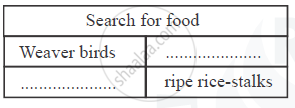Advertisements
Advertisements
प्रश्न
Read the following sentence aloud. Write who said it and to whom.
“What! ... how ! ... That’s impossible! ”
उत्तर
The above sentence was said by M. Loisel to Mathilde.
संबंधित प्रश्न
Complete the following table :

Briefly explain the following statement from the text.
“You need some interaction to cause a transition.”
Discuss the following in pairs or in groups of four:
“Tribal arts are not specifically meant for sale.” Does this help or hamper their growth and preservation?
Using a dictionary/internet note down the main difference between a remote-sensing satellite and a natural satellite.
Read the story and choose the appropriate meaning.
Skeleton branches ____________.
Fill in the gaps in the table of Degrees of Comparison.
| Positive | Comparative | Superlative | |
| (1) | ____________ | ____________ | oldest |
| (2) | ____________ | healthier | ____________ |
| (3) | near | ____________ | ____________ |
| (4) | ____________ | finer | ____________ |
| (5) | ____________ | ____________ | earliest |
| (6) | small | ____________ | ____________ |
| (7) | ____________ | faster | ____________ |
| (8) | high | ____________ | ____________ |
Fill in the gap, choosing a word from the bracket to make an appropriate comparison.
(tall / quiet / humble / merry / busy / slippery / fast / sly / slow / big)
as ______ as a fox
'It all builds on the charm of the 1967 film, which by itself is a must-watch for any child.'
Explain this sentence in the context of the movie, focusing on the two given phrases- 'Charm of the 1967 film' and 'must-watch'.
What could have happened to the one who flew away? Who was she?
Name any four periods of History of British Drama.
Correct the given sentence with justification.
Since there is a reference to the Indian boy, there are some scenes from India too.
Discuss the following questions after you have seen a presentation of the ‘ad’.
Can you become fair in five days? How long will the effect of the cream last?
On any one page, note against the speech of every character what feelings it should show to bring out the meaning best. For example, joy, fear, anger, nervousness, friendliness, dislike, surprise, wonder, excitement, politeness, rudeness, cunning, curiosity.
What two basic rules were followed in the Science Fair?
Write all the instances of the mischief done by Mr. Nobody.
Read the ode ‘To Autumn’ by the famous poet John Keats. ‘Season of mists and mellow fruitfulness...’
Put the following expressions in a table of Do’s and Don'ts as expressed by the poet.
- Please listen
- give me advice
- tell me why
- solve my problem
- just hear me
- accept as a simple fact
- contribute to my fear
- wait a minute
| Do’s | Don'ts | |
| 1. | ||
| 2. | ||
| 3. |
Gather more information about cold winters in Russia.
Show the major events in the story of Pheidippides on a ‘time-line’.
How was the young seagull’s first attempt to fly?
Read the following line from the poem and answer the question that follow.
Let me but live my life from year to year, With forward face and unreluctant soul; Not hurrying to, nor turning from the goal; Not mourning for the things that disappear.
Identify the rhyme scheme of the given lines.
Why were the policeman prevented from entering grandfather's room?
Why did Dr. Ashok’s cousin call him?
With their treasure, the boys would buy ______ in Eidgah.
What do you infer about speaking with others from this poem?
Read the line and answer the question.
And the wheel’s kick and the winds song and the white sail’s shaking
What according to the poet are the pleasures of sailing?
The terrorists asked Neerja to collect the passports of the passengers because ______.
What did Grandmother feel about trees growing in the house?
What does ‘charges along like troops in a battle’ mean?
There is a connection between the rhyming words and rhythms of the train. Present your views about it.
Why did the farmer have to travel far?
They all stood around the little jewel of blue means______.
How does Patna differ from Delhi?
Read scene I of the play carefully and answer the question below.
Match the following.
| Sr.No. | CHARACTER | TRAIT |
| a. | Father Wolf | with a grey nose…feeds her four cubs |
| b. | Tabaqui | the big one from Waingunga River with a lame foot |
| c. | Mother Wolf | the chief of the Wolves |
| d. | Shere Khan | begs for meat and thanks for the meal/warns the wolves about the arrival of Shere Khan |
What did you learn from this lesson?
The hen-pigeon returned home when it started to _______.
What will you do if you have a gold plate?
Finally, ______, he got permission to study Science.
Match with the opposite gender.
| 1. | prince | bridegroom |
| 2. | hero | princess |
| 3. | bride | heroine |
Read the following sentence.
‘A very wise man once remarked that of the unspoken word, you are a master; of the spoken word, you are a slave.’
The sentence has two pairs of opposites - spoken and unspoken, and master and slave. The contrasting ideas make the sentence more effective. Putting together opposite or contrasting ideas in one sentence is a literary device. It is called antithesis.
Read the following examples of antithesis.
- Give every man thy ear, but few thy voice.
- Man proposes and God disposes.
- Speech is silver, but silence is gold.
- Patience is bitter, but it has a sweet fruit.
